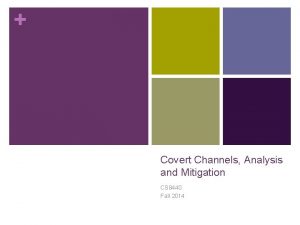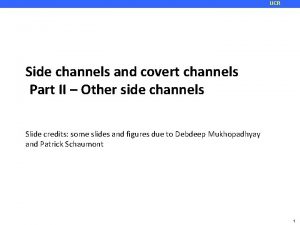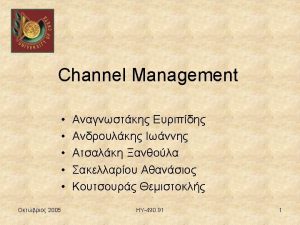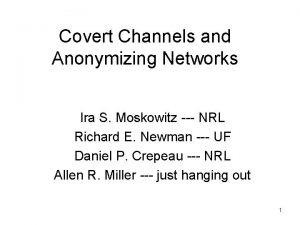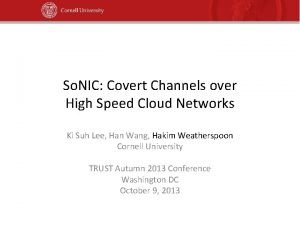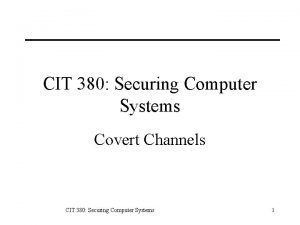Covert Channels Analysis and Mitigation CS 8440 Fall





























- Slides: 29

+ Covert Channels, Analysis and Mitigation CS 8440 Fall 2016

+ Introduction n Covert channels are a means of communication between two processes n Processes may be: n n n One process is a Trojan n n Authorized to communicate, but not in the way they actually are Prohibited from communicating Transmits data covertly The other is a Spy n Receives data

+ Outline n Definitions n Covert channel examples n Local channels n Remote (network) channels n Channel discovery and analysis n Channel mitigation

+ Covert Channels n Covert channels arise because subjects share resources. n The shared resources allow one subject (the transmitter) to modulate some aspect of how another subject (the receiver) perceives the system. n Covert channels are generally grouped for working purposes into: n n storage channels (where the values returned to the receiver by operations are affected). timing channels (where the times at which events are perceived by the receiver are modulated).

+ Covert Channels n “Parasitic” communications channel n n hidden within the medium of a legitimate communications channel Storage channel: Communicate by modifying a stored object n Examples: n n a storage location is written with confidential data; then a public process reads that location a shared buffer is first written with confidential information, then, assuming the buffer is not “zeroed out”, a public process retrieves that information n Storage Book” n n & Timing channels are defined in the “Orange Originally in Butler Lampson’s “A Note on the Confinement Problem”, 1973. On the website

+ Covert Channels (cont’d) n Timing channel: Transmit information by affecting the relative timing of events n Example: the execution of processes at one level affects when processes at another level execute or which resources are available n E. g. , a Hi process and Lo process conspire to circumvent system security. The Hi process will attempt to acquire the disk drive at midnight n n The Lo process knows that, if the disk is unavailable at midnight, then “we attack at dawn”; otherwise, not. Timing channels are very difficult to avoid on time-shared systems

+ Where and What? n For a covert channel to exist, it must be the case that: n A multi-level system is in use n A resource (or one of its attributes) is shared by high (Trojan) and low (spy) processes

+ Definitions of Channels n Covert channel: Intentionally used to communicate n Side channel: Unintentionally reveals information n Steganography: Techniques for hiding the very presence of communication n Subliminal channel: Covert channel with mathematically proven steganographic properties n Ex: human speech. n Even # words = 0 n Odd # words = 1 n “how do you do? ” 0

+ Why Are They Important? n Difficult to detect n Can operate for a long time and leak a substantial amount of classified data to uncleared processes n Can compromise an otherwise secure system, including one that has been formally verified! n Must be considered to achieve high government certification levels

+ Local Channels

+ Resource Manipulation n Trojan fills kernels process table to transmit 1, leaves it partially empty to transmit 0. Spy tries to create process. n Trojan allocates 0 MB of memory to transmit 00, 64 MB to transmit 01, 128 MB to transmit 10, 192 MB to transmit 11. n n Easily distinguishable by any spy with resource monitoring capabilities Trojan induces bus contention, spy measures bus latency (multiprocessors) n Will multicores cause resurgence?

+ Resource Exhaustion Countermeasures n Preallocate resources and prevent dynamic modification n Only used when covert channels pose a serious enough risk to justify the inefficiency

+ Disk Arm Optimizations To send a bit: Starting at 2 To send a 0: High: 1 To send a 1: High: 3 Low: 0, 4 (assumes elevator algorithm) 0 1 2 3 4 Karger, Wray, “Storage Channels in Disk Arm Optimization”, 1991 Spy process observes which request finishes first to receive bit: - 0 first = 0 transmitted - 4 first = 1 transmitted Bandwidth = 23 -56 b/s in 1970

+ Disk Arm Countermeasures n Return n disk arm to fixed position after each seek Awful performance, not portable n Only issue requests from one class of processes at a time, and restore disk arm direction when returning to low process n Not portable, hard to implement n Return disk blocks to software in the order they were requested n Batch n No requests in pseudorandom time quanta proofs for these approaches

+ Cache Missing for Fun and Profit n Hyper-Threading permits two threads to execute on a single Pentium 4 core n Cache is shared between threads (Trojan and spy) Arstechnica. com Percival 2005, “Cache Missing for Fun and Profit”

+ Cache Missing (cont. ) n Trojan horse (in high process) runs one thread, spy runs another n Trojan allocates 2 KB array (in L 1 cache) n Spy allocates 8 KB array (in L 1 cache) Trojan (in Open. SSL) 2 KB Spy 8 KB Nuwen. net

+ Cache Missing (cont. ) n To transmit a 1 bit, Trojan accesses corresponding location in array, evicting one spy cache line n When spy reloads cache line from L 2 cache, additional 30 cycle latency n 32 bits per 5000 cycles, < 25% error rate n 400 KB/s on 2. 8 GHz processor n Size of RSA/DSA private key usually < 256 B

+ Cache Missing Countermeasures n Architecture-level: n Don’t share caches between threads n n Change cache eviction strategy to enforce fair sharing between threads n n More expensive, slower Performance penalty OS-level: n Make sure low- and high-level processes never share the processor simultaneously

+ Channel detection and analysis

+ Analysis Techniques n n Information flow n Operates at high-level language level n Often overestimates flows, flags non-existent flows Noninterference n n Analysis performed on abstract model, not real system Shared Resource Matrix n Very popular with systems folks Sabelfeld, Myers 2003, “Language-Based Information-Flow Security”

+ Shared Resource Matrix n If row has both R and M, attribute may permit covert channel to exist n R, M are permissions n R = read n M = modify Kemmerer 1983, “Shared Resource Matrix Methodology: An Approach to Identifying Storage and Timing Channels”

+ Advanced channel mitigation

+ Fuzzy Time n All covert timing channels rely on accurate clock n You can either attempt to disrupt the timing of the channel (add noise or slow it down), or reduce the accuracy of the clock n VAX security kernel slows down timer interrupt periods to be uniformly distributed with a mean of 20 ms. n Randomly modifies the completion time of I/O requests, so they can’t be used as a clock Hu 1991, “Reducing Timing Channels with Fuzzy Time”

+ Lattice Scheduling n Many local covert channels require simultaneous operation of spy and Trojan n n Process scheduler can be modified to prevent this situation Recall cache missing attack… n This is actually the same sort of attack presented in this VAX security kernel paper! n Demonstrates that covert channels haven’t been taken seriously Hu 1992, “Lattice Scheduling and Covert Channels”

+ References n Wray; “An Analysis of Covert Timing Channels, ” Research in Security and Privacy, 1991. Proceedings. , 1991 IEEE Computer Society Symposium on n Hu; “Reducing Timing Channels with Fuzzy Time, ” Research in Security and Privacy, 1991. Proceedings. , 1991 IEEE Computer Society Symposium on n Kemmerer; “Shared resource matrix methodology: an approach to identifying storage and timing channels, ” CM Transactions on Computer Systems (TOCS) 1983

+ References n Sohn, Noh, Moon; “Support Vector Machine Based ICMP Covert Channel Attack Detection, ” Computer Network Security: Second International Workshop on Mathematical Methods, Models, and Architectures for Computer Network Security, MMM-ACNS 2003 n Buchanan, Llamas; “Covert Channel Analysis and Detection with a Reverse Proxy Servers using Microsoft Windows”

+ References n Moskowitz, Newman, Crepeau, Miller; “A detailed mathematical analysis of a class of covert channels arising in certain anonymizing networks”, Naval Research Laboratory n Sabelfeld, Myers; “Language-Based Information-Flow Security, ” Selected Areas in Communications, IEEE Journal on, 2003

+ References n Kelem, Feiertag; “A Separation Model for Virtual Machine Monitors, ” Proc. IEEE Symposium on Security and Privacy, 1991 Greenstadt, Litwack, Tibbetts; “Covert Messaging through TCP Timestamps, ” Proceedings of the Privacy Enhancing Technologies Workshop, 2002 n Giffin, n Kuhn, Anderson; “Soft Tempest: Hidden Data Transmission Using Electromagnetic Emanations, ” Information Hiding, Second International Workshop, IH, 1998

+ References n Hu; “Lattice Scheduling and Covert Channels, ” Research in Security and Privacy, 1992 n Le. May, Tan; “Acoustic Surveillance of Physically Unmodified PCs, ” Security and Management 2006
 Sefram 8440
Sefram 8440 Overt prestige
Overt prestige Covert observation
Covert observation Advantages of overt observation
Advantages of overt observation Covert prestige and overt prestige
Covert prestige and overt prestige Overt and covert conflict in the workplace
Overt and covert conflict in the workplace What is homicide
What is homicide Covert behavior examples
Covert behavior examples Covert attention
Covert attention Covert grammar teaching
Covert grammar teaching Attention physiology
Attention physiology Behavior domain
Behavior domain Covert attention
Covert attention Advertising includes
Advertising includes Come fregare un narcisista covert
Come fregare un narcisista covert Advantages and disadvantages of inductive method
Advantages and disadvantages of inductive method What is a covert contrast
What is a covert contrast Covert sensitization
Covert sensitization Covert text
Covert text Covert prestige definition
Covert prestige definition 11 from binary to decimal
11 from binary to decimal Covert storage channel example
Covert storage channel example Covert narcissist
Covert narcissist Covert action
Covert action Covert objectives
Covert objectives Risks and mitigation slide
Risks and mitigation slide Delay and dispute mitigation
Delay and dispute mitigation What are disasters
What are disasters Environmental enhancement and mitigation program
Environmental enhancement and mitigation program Mold removal somerset county
Mold removal somerset county






























